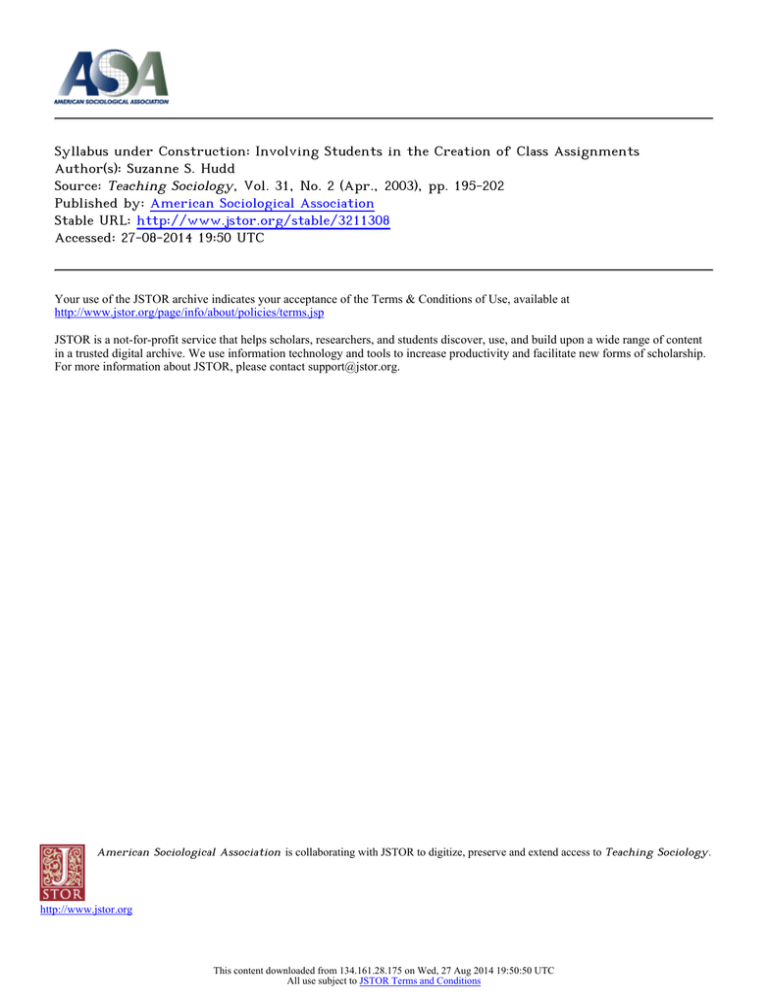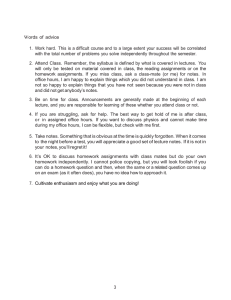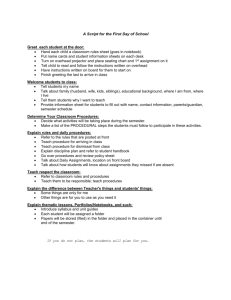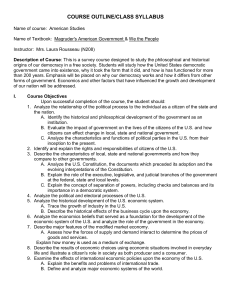Syllabus under Construction: Involving Students in the Creation of Class Assignments Author(s): Suzanne S. Hudd
advertisement

Syllabus under Construction: Involving Students in the Creation of Class Assignments Author(s): Suzanne S. Hudd Source: Teaching Sociology, Vol. 31, No. 2 (Apr., 2003), pp. 195-202 Published by: American Sociological Association Stable URL: http://www.jstor.org/stable/3211308 Accessed: 27-08-2014 19:50 UTC Your use of the JSTOR archive indicates your acceptance of the Terms & Conditions of Use, available at http://www.jstor.org/page/info/about/policies/terms.jsp JSTOR is a not-for-profit service that helps scholars, researchers, and students discover, use, and build upon a wide range of content in a trusted digital archive. We use information technology and tools to increase productivity and facilitate new forms of scholarship. For more information about JSTOR, please contact support@jstor.org. American Sociological Association is collaborating with JSTOR to digitize, preserve and extend access to Teaching Sociology. http://www.jstor.org This content downloaded from 134.161.28.175 on Wed, 27 Aug 2014 19:50:50 UTC All use subject to JSTOR Terms and Conditions SYLLABUSUNDERCONSTRUCTION:INVOLVING STUDENTSIN THE CREATIONOF CLASSASSIGNMENTS* Collaborative teaching techniques are designed to alter the relationship between the professor and the students in order to share the process of learning class materials. In a collaborative classroom, students are encouraged to participate in the design and implementation of class materials. This paper presents an exercise in which the students are required to develop the assessment criteria for a class in introductory sociology. In the first class session, students are given a syllabus including only topical headings and are charged with constructing the list of graded assignments. It is noted that, by and large, students respond positively to being included in the design of the class syllabus, and some of the logistical concerns and pedagogical constraints of implementingthis exercise are described. SUZANNE S. HUDD Quinnipiac University distinguishedby a numberof uniquefeastudentsdevelop a set of assignmentsto tures:learningis activeratherthanpassive, assess theirperformancein an introductory the teacheractsas a facilitator,teachingand sociologyclass. Studentsare engageddur- learning are shared experiencesbetween ing the first few classes in creatingtheir studentsand faculty, lecture is balanced assignmentsfor the semesterwith the goals with small-groupactivities,and both social of setting a tone of collaborativelearning and team skills are developedthroughthe from the first day of class and enhancing give-and-take of consensus building participationand studentownershipof the (Matthewset al. 1995). In a collaborative class. In the wordsof Rinehart(1999), this learningmodel,teachersand studentswork exerciseis designedto shift studentsfrom as a teamto createa learningenvironment the role of educationalconsumersto "co- characterized andpower by interdependence creatorsof a common life" in the class- sharing. This model acknowledgesthat room. In providinga frameworkfor this knowledgeis a socialconstructin whichthe exercise, Haynes (2001) notes that such teacher'srole is to create an environment studentempowerment can lead to increased wherethe studentscan createmeaningfrom motivationand participationand improved classcontent(SmithandWaller1997). skills. Muchresearchhas been done on the efproblem-solving Collaborativelearning classrooms are fects of collaborativelearning. This research notes that collaborativeclassrooms "*Iwould like to thank Lynne Hodgson and tendto be associatedwith moresubstantive the anonymousreviewers for their comments on coursecontent,higherlevels of studentsatearlier drafts of this paper. Please address all isfaction, increasedstudenteffort, higher correspondenceto the author at the Department levels of academic persistence,and the deof Sociology, College of Liberal Arts, Quinnipof stronger velopment interpersonalrelaiac University,275 Mount Carmel Avenue, students andfaculty(Baker CT tionships among Hamden, 06518; e-mail: suzanne.hudd@quinnipiac.edu. 1999; Marx 1998). Collaborativelearning Editor's note: The reviewers were, in techniquescan also buildtrustbetweenstudents and faculty. Brookfield(1999) dealphabetical order, Janet Bogdan, Martin J. an exercise in which THISPAPER DESCRIBES Malone, and Allen Scarboro. Teaching Sociology, Vol. 31, 2003 (April:195-202) This content downloaded from 134.161.28.175 on Wed, 27 Aug 2014 19:50:50 UTC All use subject to JSTOR Terms and Conditions 195 196 TEACHINGSOCIOLOGY scribes "takingstudentsseriously" as an theirperformance is assessed. essentialprerequisiteto creatingeffective Sweet (1998) argues that such radical learning relationships. Clearly, the in- shifts in powerare rarelyfully achieved,in creasedopportunitiesfor studentinput in part due to institutionalconstraintsthat the collaborativeclassroomsignal to stu- serve to limit instructionaloptions. The dentsthattheiropinionsmatter.As a result, exercisedescribedhere demonstrates power collaborativeclassroomsare characterized shiftingin a way thatis immediatelytangiby consensus building (Brufee 1999). ble to students.Studentsare put into an Throughincreasedinteractionin learning, active role on the first day of class and studentsobservethatthey are co-creatorsof askedto provideinputintothe coursesyllaof the knowledge;this observationin turnenables bus (and,arguably,the infrastructure themto recognizetheir individualways of course).Empowering studentsin thisway at discoveryand understanding.In addition, the outsetsets the tone for a participatory studentsin collaborative settingslearnsocial learningexperience. skills (e.g., the abilityto work throughan issuewitha group).Thesetypesof learning THE EXERCISE them with experiencesprovide knowledge and skills that extend beyond the content My introductory sociologyclasses are typimatterof the course(Johnsonand Johnson cally comprisedmostlyof freshmenand a small percentageof upperclassmen.Most 1997;Vella 1994). Some researchhas hypothesizedthat stu- of the studentswho enroll seek to fulfill a dentsarriveon campusfocusedon the so- core requirement, althougheach semestera cial aspectof college and need to establish studentor two choosesto majorin Socioland stabilizepeer relationshipsbefore they ogy. I spenda portionof the firstclass sescan concentrateon academictasks (Moore sion discussingthe collaborativetechniques 1998). In this regard, collaborativeclass thatcharacterize my teachingstyle. I advise environmentsmay be more effective be- studentsthattheywill be assignedto a small cause they enablestudentsto addresstheir groupfor the remainder of the semesterand social and academic interests simultane- thatin manyof ourclass sessions,theywill ously. Collaborativeclassroomsmay also participatein an exercise, discussion,or be popularbecause they accommodatea some sort of projectwith theirgroupmemvarietyof learningstyles (Johnson2001). bers. I also encouragestudentsto consider However,collaborative techniquesrequirea groupwork as one optionfor gradedwork certainamountof flexibilityand openness as they beginto constructtheirassignments on the partof the instructorand they may for the semester. not be fully effectiveif not employedcareDuringone of the initialclass lectures,I discussvariousgroupdecision-making techfully(Marx1998;Rinehart1999). Anothercrucialcomponentof collabora- niques.The studentsare encouragedto contive learning experiences is overcoming sider both the group's decision outcomes power relationsin the classroom(Gamson anddecisionprocessesas important learning 1994).Theoretically,an instructorin a col- experiences.Throughoutthe variousgroup laborativeclassroommustbe willingto "let activitiesin the semester,I am carefulto go" andbe guidedby studentinterestsand emphasizeand guide the studentstowards concernsin sucha way thatthe relationship the applicationof core course conceptsin between studentsand instructorand between students and material are primarily studentguided. This shift in power affords the students increased opportunities for input into course content, the"format in which the material is presented, and the manner in which the text, but I allow this to happen as the discussion evolves rather than using a predetermined lecture format. In this sense, I present the assignment creation exercise described in this article as an introductory collaborativelearning exercise-one that sets This content downloaded from 134.161.28.175 on Wed, 27 Aug 2014 19:50:50 UTC All use subject to JSTOR Terms and Conditions SYLLABUSUNDERCONSTRUCTION the tone for my expectationsregardingstudentparticipation for the rest of the semester. Afterprovidingthe studentswith an overview of my pedagogicalstyle, I distributea "skeleton"of the class syllabus,includinga topicfor eachweek alongwith the text and supplementalreadings correspondingto each topic. No assignmentsappearon the syllabus, and studentsare told that their first task of the semesterwill be to create the assignmentsby whichtheirperformance in my class will be assessed.I have limited the "creative"aspectsof this projectto the developmentof gradedassignmentsrather thanthe constructionof the entiresyllabus for severalreasons.First, since this is an introductorycourse, many students have only a vaguesense, if any, aboutthe topics thatwill be covered.Second,althoughstudents can readilydiscernthe topics to be studied by looking at the text, teaching these topics could be cumbersomewithout considerationof the order and context in which they would best be presented.Finally, while it mightbe interestingto begin the class with no text and a randomlist of topicalareaslisted on the board,the logistics of orderingtextbooksmakes this approachimpractical. The texts I have generallyused for IntroductorySociologyare Newman,Sociology: Exploringthe Architecture of EverydayLife (ThousandOaks, CA: Pine Forge Press, 2000); Finsterbusch,Sociology00/01: Annual Editions (Guilford, CT: Dushkin, 2000); and Finsterbusch,TakingSides:Social Issues (Guilford,CT: Dushkin,2000). I use the Newmantextto providea theoretical overviewfor each of the topicswe will coverandtheAnnualEditionstext as a supplementalreader.It has beenmy experience thatstudentswho strugglewiththe concepts as they are presentedin Newmancan often readilybecomeengagedin a discussionof social issues related to these concepts. The Annual Editions text provides the students with "real" examples of sociology in action and offers them a potentially broader range of material from which to create their as- 197 signments.I also includea secondFinsterbusch text, TakingSides, on the required readinglist, althoughI do not formallyinclude assigned readings from it in the "skeleton"syllabus. Instead, the students are encouragedto examine which issues from this text interestthem and how they wish to incorporate severalof theseintothe class syllabus.TakingSides presentstopics in a debate-orientedformat; however, I have used this text as the basis for a broad arrayof assignmentsincludingformalclass debates,papers,and class discussionexercises. As their first homeworkassignment,studentsare chargedwith independently devellist of for a the semester assignments oping usingthe class textsandtopicalassignments outlinedon the "skeleton"syllabus.I encouragestudentsto reflect on the assignmentsin a numberof ways. First,theymust considerthe typesof assignmentsthey prefer (e.g., quizzes,oralreports,etc.). Next, they mustdiscerntheirpreferencesfor content of the assignments.For example,if a studentindicatesthatshe favorsa series of exams,shouldthe examsbe multiplechoice or essay? Studentsare also instructedto examinethe timingof the assignments.Specifically,theyare askedto look at theircalendarsfor the semesteranddecidewhether they preferdue dates that are more traditional (e.g., a midtermduring midterm week) or whetherthey preferassignments scheduledat alternatetimes. This aspectof the exercisehas the addedbonusof helping themto assesstheirworkloadfor the entire semester.I also encouragethe studentsto think about diversityin assignmenttypes, the quantityof work to be performedand the weightingof the various assignments on one assign(suchthatpoorperformance ment does not automaticallyequate to a poor gradein the class). Finally,I ask the students to choose the six issues from Taking Sides they find most interesting and to reflect on how these issues might be incorporated into the class in either a graded or non-graded format. I provide the students with a written handout for submittingtheir This content downloaded from 134.161.28.175 on Wed, 27 Aug 2014 19:50:50 UTC All use subject to JSTOR Terms and Conditions 198 TEACHINGSOCIOLOGY assignmentpreferences(see Appendix),and assignmentlist. My experienceshows that instructstudentsto returnto the next class after several class sessions with an openmeetingwith their assignmentsheets com- ended syllabus, students are anxious to pleted,readyto discusstheirchoices. bringclosureto the assignmentlist. Perhaps At the startof the secondclass, I immedi- this is due to the fact thatwe are into the atelydividethe studentsinto theirassigned secondweekof classesat this point,andthe groupsand give them aboutthirtyminutes students'workloadsfor other classes have to developa groupconsensuson an assign- beenset. mentlist for the semester.The membership The performanceof studentsin classes of each groupis essentiallyrandom;how- using a collaboratively constructedsyllabus since I teach at a that is is in several ever, college preunique ways. In my experiI am careful to to few students fail or performpoorlyin ence, dominantlyfemale, try provide a mix of genders in each group classes where they have been involvedin whenfeasible.To the extentpossible,I also constructingthe assignmentlist. I attribute try to distributethe few upperclassmen this in partto the opendiscussionof assessamong various groups since in most in- ment and performancethat begins in the stancesthey offer a more "seasoned"per- very first class session. Thus, the average spective.I offer the class a brief overview studentgradesfor these classes tend to be of groupdecision-making strategies,suchas slightly higher, primarily because the on a particulartopic or al- grades of the poorestperformersimprove brain-storming lowing each memberto speak in turn and under this system. In addition,I tend to developinga comprehensivelist for discus- have more interactionwith studentsat both sion, thenchargethe groupswithcreatinga the high andlow endsof the gradecurvein classes.Highperforming single list of assignments.Once groupde- thesecollaborative liberationsare complete,I ask thata repre- studentstypicallywantto discussclarificasentativefrom each group write its final tion of assignmentsandprocess,while stuassignmentlist on the boardfor class dis- dentsperformingpoorly frequentlyrequest cussion. extra credit opportunities.In sum, these In my experience, the group lists are interactionssuggestthat studentswho have characterized by a fair amountof overlap. collaboratedin constructingtheir assignWhile students infrequentlygenerate an mentsbecomemore personallyinvestedin innovativeidea (e.g., an in-class group the course content and the evaluationof exam),the vast majorityof the assignments theirperformance. are fairlytraditionaland discussionfocuses on preferencesfor exams, papers, or oral POTENTIAL PROBLEMS presentations,as well as the timing and weightingof these variousassignments.As The main difficultyI have experiencedin the instructor,I try to orchestrate class-wide implementingthis exercise is logistical. discussionsuch that each memberof the Becausethe assignmentlist is not finalized classfeels comfortableexpressinghis or her until the third class meeting,the syllabus mustremaina workingdocumentfor a coupreferences. Oncethe class has developedand agreed ple of weeks into the semester.Typically, upon a single set of assignmentsfor the the beginningof the semesteris a busytime the information onto andthejob of havingto finalizethe syllabus semester,I incorporate a final version of the syllabus. At the start of our third class meeting, the students are given one last opportunity to review the assignments and to ask any outstanding questions. I have structuredthis session as the last opportunity for class input on the while teaching poses somewhat of an added burden.I have foundit helpfulto construct the class assignments with due dates as a separate sheet, to be attached to the "skeleton syllabus" as an appendix. I also encourage students to add assignment due This content downloaded from 134.161.28.175 on Wed, 27 Aug 2014 19:50:50 UTC All use subject to JSTOR Terms and Conditions SYLLABUSUNDERCONSTRUCTION 199 datesto the class outlineso that these im- the course requiresof them. This is espestudents cially true for higher-performing portantdatesappearin two places. on their who list the of assignments begin working student-generated Interestingly, assignmentshas not been terriblyinnova- well in advanceof due dates.As in the trative, employingthe standardtypes of as- ditional class, the syllabus becomes a signmentstypicallyprovidedin an introduc- "contract"for students'work load, and it torycourse(e.g., some shortpapers,exams can be unnervingwhenstudentssuspectthat and oral presentations).While I was ini- assignmentscould be createdor dropped the courseof the semester. tially surprisedby this lack of creativity,I throughout As one studentnotes in her evaluation, attributeit to the fact thatby the time they enroll in an introductorycollege course, the mainlimitationof this exerciseis thatit studentshave been socializedin secondary uses class timethatcouldbe usedfor teachschool to recognizeand accept traditional ing purposes.Some studentsview the creamethodsfor performanceassessment.One tion of assignmentsas the "instructor's this narrowview job." However,only a minorityof students strategyfor counteracting of assignmenttypes might be to leave as- expressthis sentiment.Even studentswho signmentsoff of the syllabusfurtherintothe indicateconcern over lost class time desemester,conductingseveralothercollabo- scribethe syllabusconstructionexerciseas rativeexercises duringthe course's initial providingthemwith otherbenefitssuch as weeks, and then engagingthe studentsin gettingto knowtheirclassmatessoonerand assignmentcreation.This would give the having an appreciationfor developingasstudentsa chance to become comfortable sessmenttools. withone another,to experiencethe collaboCONCLUSION rative classroomenvironmentmore fully, andto witnessmy encouragement of student innovation.Likewise,the delaywouldallow Studentfeedbackin relationto the syllabus studentsto gain a better understanding of constructionexercisehas been overwhelmthe coursecontentandthey mightbe better ingly positive. I assess studentreactionsto preparedto thinkof creativeways to dem- the exerciseboth at the beginningand the onstrate their knowledge. This strategy end of the semester.Where concernsare might be more effective in an advanced noted,theytypicallyspeakto the contentof class, wherestudentsare morefamiliarwith individualassignmentssuch as groupwork. the "traditional"framework of college Onlya few studentshavedescribedthe task coursesand so may have less anxietyabout of constructingassignmentsas "confusing" or "difficult."Manystudentsalso comment needingto finalizethe assignmentlist. Anotherdifficultythatcan arisefromthe that their class participation increasedas a collaborativeassignmentexercise is some resultof being engagedin this process.As students'perceptionof the course syllabus one studentnotes: "I enjoyedtakingan acas a document that can be negotiated tive part...[Theexercise] affectedmy perthroughoutthe entire semester.In particu- ceptions,as I enjoyedthe class and took a lar, I haveobservedthatstudentswho have moreactiverole."Thesecommentscontrast helpedcreatethe assignmentlist are more with my observationsthatno dramaticdiflikelyto seek new extra-creditopportunities ferenceexistsin the level of classdiscussion midwaythroughthe semester.For this rea- and participationbetween regular classes son whenI handout the finalsyllabusin the andthose wherethe assignmentsare develthird class, I stress to students it represents the final list of assignments for the semester. They will not again be allowed to reconstruct, add to, or otherwise alter the list. The majorityof students seem to prefer this closure and the security of knowing what oped collaboratively. Why do students perceive that their participation is enhanced? It may be that certain students are, in fact, more active than they might have been in a traditionalclass- This content downloaded from 134.161.28.175 on Wed, 27 Aug 2014 19:50:50 UTC All use subject to JSTOR Terms and Conditions 200 TEACHINGSOCIOLOGY room, while the participationof others is more subdued. Perhaps when students recognize that their participationis welcomed, they actually perceive that they participate more. It would be interesting to implement this exercise in conjunction with more specific techniques targeted to enhance discussion and class participation such as "buzz groups" or the creation of an "inner circle" (McKeachie 1994). The inclusion of such techniquesmight yield a more fully studentdriven class in terms of both content and process. Studentcomments suggest that the assignment construction exercise enhances their learningexperience beyond the content matter of sociology. As one student describes: "It was like giving us the power which was a different thing. Instead of just walking into a class and receiving an agenda, we made our own." Many students express feelings of being "in control" or that I was "interestedin their opinion." In this regard, the exercise provides an importantopportunity to reinforce the sociological concepts of inequality and power and the extent to which such structural arrangements constrain behavior. Presented in this context, this exercise could be used to demonstrate the notion that power can be shifted, and the class might be engaged in an assessment of how behaviors can change when power gradientsare altered. As a result of this exercise, studentslearn at the outset that their opinions matter and thus they are more immediately immersed in the learning process. One student summarizes this perspective quite well: allowing studentsto "...choose their assignments is a way to earn their respect and by doing that they'll listen." Listening is an essential first step in the process of engaging students more fully in the classroom experience. APPENDIX What Will Your Assignments for the Semester Be? Whatis the process for deciding on class assignments? The syllabusliststhe topicsandreadingswe will cover this semester.We will begin our second class with a small groupexercise.Duringthis exercise,you (as a class) will decidethe assignmentsfor the entiresemester.Youwill beginthis processin smallgroupdiscussions.We will then bringall thegroupstogetheranddecideas a class on a finallist of gradedassignments. I will make to thesyllabus(e.g., addan necessaryadjustments in-classexam,discussion,etc.).Thefinalversion of the syllabus-with the gradedassignmentswill be presentedfor yourreviewandapprovalin thethirdclass. How do I begin to preparefor the group exercise on January 25? Therearea seriesof stepsyou shouldgo through to prepare yourselfforthesmallgroupexercise. 1. Readthe introductory chapterin thetextand the readerto get a very generalsenseof the courseconcepts. 2. Thinkaboutwhattypesof assignmentsyou wouldliketo haveduringthe semester(e.g., exams, quizzes,shortpapers,gradedgroup exercises,debates,grouppresentations, etc.) andmakea roughlist. 3. Considerthe contentof these assignments (e.g., If you want an exam do you prefer essayor multiplechoice?If you havelisteda paper,whatwill the topicbe andhow long will the paperbe? Will it involveresearch?) 4. Detail is importantfor this section of the assignment. Finally,considerthe timingof the assignmentsyou have developed.Lookat the semesterschedule,and think about the due dates for your otherclasses,midterms,etc. whenyou considerduedatesforyourassignments.Pleasenotethatthesyllabusdoes not includeany readingsfromthe TakingSides text. Witha copy of this book,you should: 1) identifywhich readingsare of greatest interestto you;and2) considerwhetheryou wish to includesome sortof gradedassignmentusingthistext. I haveattacheda copy of the class schedulethat you can markup withassignmentsalongwith an assignmentplanningsheet that you can use to andlistthe TakingSides expressyourpreferences issuesin whichyou aremostinterested.Cometo class with the assignmentpreferencesheet completed so that you are preparedto discussthis information withyourclassmates. What criteria should I use to create a list of assignments? Instructorstypically use a numberof criteria whenthey arecreatinga set of assignmentsfor a classduringthesemester.Thelist belowprovides This content downloaded from 134.161.28.175 on Wed, 27 Aug 2014 19:50:50 UTC All use subject to JSTOR Terms and Conditions 201 SYLLABUSUNDERCONSTRUCTION you with some of the goals professors have when they develop assignments. Think about which of these is most importantto you. 1. 2. 3. 4. 5. to the final withdrawaldate. How will we make our final decision on assignments? Comprehensionof the readings and in class We will use a group process for deciding upon the material. class assignments. Once your groups have met, Ability to write and speak about the subject we will come together as a class and discuss the matterpresentedin class. assignment lists each group has created. I hope Multiple types of assignments to demon- that throughdiscussion, we can achieve a consenstratewrittenand oral comprehension. sus on the assignment list. If we cannot reach a Adequate assignments so that poor perform- consensus, however, we will take an anonymous ance on one assignment does not mean poor vote in class on the various options being considered. The assignment list for the semester will be performancein the class as a whole. Timing of assignments-i.e., it is important presentedon during the third class for your final for me to be to able to give you a sense of review and approval. your grade in the class at midtermand prior Assignment Planning Sheet Bring to Second Class Session Class: Name: 1. Assignment Choices Assignment Type Assignment Content Due Date Example:Exam Mix essay and multiplechoice questions 2/13/01 2. Preferred Readings in Taking Sides: 1. 2. 3. 4. 5. 6. a. Would you like to use the Taking Sides book to create a graded assignment? (Ifyes, use the space at the bottom of the page to describe the assignment.) Yes No 3. Please list the factors you considered in creating the assignment list. You can choose from the criteria listed on the bottom of page 1, or identify other factors that influenced your thinking. 1. 2. 3. 4. 5. 6. Bring the completedsheet to class-it will be collected!!! This content downloaded from 134.161.28.175 on Wed, 27 Aug 2014 19:50:50 UTC All use subject to JSTOR Terms and Conditions TEACHINGSOCIOLOGY 202 REFERENCES Problems Often Follow." The Chronicle of Baker, Paul. 1999. "CreatingLearning Communities: The Unfinished Agenda." Pp. 95-109 in Matthews, Roberta S., James L. Cooper, Neil Davidson, and Peter Hawkes. 1995. "Building Bridges Between Cooperative and Collaborative Learning." Change 26:34-40. McKeachie, Wilbert J. 1994. Teaching Tips: HigherEducation44:B8. TheSocialWorldsof HigherEducation,edited by Bernice Pescosolido and Ronald Aminzade. ThousandOaks, CA: Pine Forge. Brookfield, Stephen. 1999. "Building Trust with Students."Pp. 447-54 in TheSocial Worldsof Higher Education, edited by Bernice Pescosolido and Ronald Aminzade. Thousand Oaks, CA: Pine Forge. Bruffee, KennethA. 1999. CollaborativeLearn- Strategies,Researchand Theoryfor College and UniversityTeachers.Lexington,MA: D.C. Heath. Moore, Robert L. 1998. "TeachingIntroductory Economics with a CollaborativeLearning Lab Journalof EconomicEducation Component." and ing: HigherEducation,Interdependence, the Authorityof Knowledge.Baltimore,MD: 29:321-29. Rinehart, Jane A. 1999. "Turning Theory into Johns Hopkins University Press. Theorizing:CollaborativeLearningin a SocioGamson, Zelda F. 1994. "CollaborativeLearnlogical Theory Course." Teaching Sociology 27:216-32. ing Comes of Age." Change 26:44-49. Haynes, Ada. 2001. "Student Empowerment: Smith, Karl A. and Alisha A. Waller. 1997. "Afterword: New Paradigms for College Student-Designed Syllabus: A Group Exercise." Pp. 215-20 in Sociology ThroughActive Teaching." Pp. 269-281 in New Paradigmsfor College Teaching, edited by William E. Learning:StudentExercises,editedby Kathleen McKinney, Frank D. Beck and Barbara Campbell and Karl A. Smith. Edina, MN: S. Heyl. Thousand Oaks, CA: Pine Forge InteractionBook Company. Press. Sweet, Stephen. 1998. "PracticingRadival PedaJohnson, David W. and Roger T. Johnson. 1997. gogy: Balancing Ideals with InstitutionalCon"Academic Controversy: Increase Intellectual straints."TeachingSociology 26: 100-111. Conflict and Increase the Quality of Learn- Vella, Jane. 1994. Learning to Listen, Learning to Teach. San Francisco, CA: Jossey-Bass. ing." Pp. 211-42 in New Paradigms for ColE. William edited by Campbell lege Teaching, and Karl A. Smith. Edina, MN: Interaction SuzanneHudd is a 1981graduateof Yale UniverBook Company. sity (B.A., psychology),whereshe also receivedher Johnson, Diane Elizabeth. 2001. "Teaching for Ph.D. in sociologyin 1997.She alsoholdsan M.P.H. Mastery: Focus on Social Theory." Teaching from the Universityof Connecticut(1985). She is of Sociology 29:163-80. currentlyan assistantprofessorin the Department University. Marx, Paul. 1998. "When Students Collaborate, Sociologyat Quinnipiac This content downloaded from 134.161.28.175 on Wed, 27 Aug 2014 19:50:50 UTC All use subject to JSTOR Terms and Conditions





